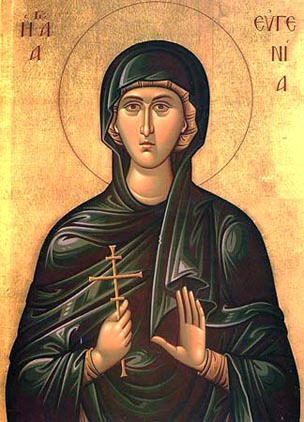
The Monastic-Martyress Eugenia
Commemorated on December 24
The
Monastic-Martyress Eugenia, by birth a Roman, lived at Alexandria, where
her father, Philip, was sent by the emperor Commodus (180-192) in the capacity
of governor of Egypt. Eugenia received a fine upbringing and was noted for her
good disposition and beauty. Many an illustrious youth sought her hand, but she
did not wish to enter into marriage. And having become acquainted with the
Epistles of the Apostle Paul, she yearned with all her soul to become a Christian
and so in secret from her parents, in the company of her two servants Protus
and Hyacinthus, attired in men's garb, she set out to a men's monastery. There
together with her servants and companions she accepted holy Baptism from bishop
Elias, who learned about her in a vision, and he gave blessing for her to
pursue asceticism at the monastery as the monk Eugene.
By her ascetic feats
Saint Eugenia acquired the gift of healing. One time a rich young woman named
Melania turned to her for help. Seeing what before her seemed a young monk,
this woman burned with an impure passion, and upon being spurned, she contrived
a slander about a forcible attempt. Saint Eugenia came to trial before the
governor of Egypt, i.e. her father, and she was forced to reveal her secret.
Her parents were exuberant, finding before them one over whom they had long
grieved. After a certain while they all accepted holy Baptism. But Philip, upon
the denunciation of pagans, was displaced from the post of governor. The
Alexandrian Christians chose him as their bishop. The new governor, fearing the
wrath of the people, did not dare openly to execute Philip, but instead
dispatched assassins. During the time of solitary prayer of Saint Philip, they
inflicted wounds upon him, from which he died three days later as a martyr.

Having thus become
widowed, Saint Claudia and her daughter and servants set out to her estates,
situated near Rome. There Eugenia continued with monastic life. She brought
many young women to Christ, and Claudia built a wanderers hostel and aided the
widowed. After the course of several peaceful years, the emperor Galienus
(260-268) began anew the persecution against Christians, and many of them found
refuge with Saints Claudia and Eugenia. During these times a young Roman girl,
named Vacilla, orphaned and of imperial lineage, heard about the Christians and
Saint Eugenia, and wanting to meet the saint she wrote her a letter. In answer,
Saint Eugenia sent her friends and co-ascetics, Protus and Hyacinthus, who
enlightened Vacilla, and she accepted holy Baptism. The servant of Vacilla then
told her fiancee Pompei, that his fiancee had become a Christian, and Pompei
made complaint to the emperor against the Christians for preaching celibacy.
Summoned to answer, Vacilla refused to enter into marriage with Pompei, and for
this they killed her with a sword. They dragged Saints Protus and Hyacinthus
into an idolous temple for making them sacrifice, but just as they entered
therein, the idol fell down and was shattered. The holy Martyrs Protus and
Hyacinthus were beheaded. They likewise by force brought Saint Eugenia to the
temple of Diana, but she did not even enter it, when all the pagan temple with
its idol collapsed. They threw the holy martyress into the Tiber with a stone about
her neck, but the stone plunged downwards and she remained unharmed. She
remained unharmed also in fire. Then they cast her into a pit, where she
remained for 10 days. During this time the Saviour Himself appeared to her and
announced, that she would enter into the Heavenly Kingdom on the day of the
Nativity of Christ. When this radiant feastday was come in the year 262, the
executioner killed the holy martyress with a sword. Saint Claudia soon also
received a martyr's crown. Saint Eugenia had told her beforehand about her day
of death.
© 1996-2001 by translator Fr. S. Janos.